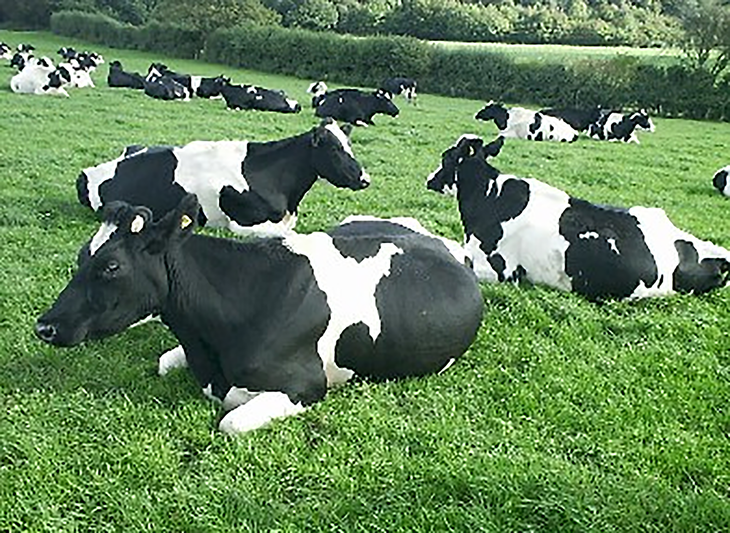U.S. dairy farmers have been steadily improving the efficiency of milk production, which in turn has resulted in a dramatic improvement in enteric methane emission intensity, according to a researcher in the College of Agricultural Sciences. Credit: Penn State
These are not your grandfather's dairy cows.
In 2014, the United States national dairy herd produced twice as much milk as it did 90 years ago, but with about 60 percent fewer cows.
These whopping productivity gains—achieved through continuous improvements in animal genetics, nutrition and management—are especially significant in these times of angst over global climate change. As a result of developing "cleaner, greener" cows, animal scientists and dairy producers have reduced by half the enteric methane emissions per unit of milk produced in this country, according to a researcher in Penn State's College of Agricultural Sciences.
One way to look at this phenomena: If the 94 million tons of milk we get now were produced by cows with 1924 emission rates, there would be an additional 1.6 million tons of methane emitted to the atmosphere, essentially more than doubling the current enteric methane emissions from U.S. dairy cows.
"The United States is one of the world's largest producers of milk and dairy products, with a dairy industry estimated at $140 billion in annual economic output," said Alexander Hristov, professor of dairy nutrition.
"Inevitable byproducts of the industry are greenhouse gases, such as methane and nitrous oxide. In 2003, dairy methane emissions from enteric fermentation and manure management represented about 11 percent of the country's total methane emissions. But U.S. dairy farmers have been steadily improving the efficiency of milk production, which in turn has resulted in a dramatic improvement in enteric methane emission intensity."
Hristov, whose recent research has focused on feed additives Hristrov, who has experimented with feed supplements that that can influence microbes and change the methane-producing chemistry of the dairy cow rumen, noted that livestock producers are striving to improve the efficiency of milk or meat production and reduce the carbon footprint of their industries.
Recently published by the Global Research Alliance on Greenhouse Gases, Hristov's article, "Reducing the Emissions Intensity of Livestock Production—A Case Study of Success," underlines a growing consensus that increased production efficiency equals lower methane emissions per unit of product. Increasing animal productivity will always decrease greenhouse gas emission intensity, he stressed.
Hristov believes that the message—increased productivity is the most efficient method to reduce greenhouse gas emissions—needs to reach producers in developing countries. The U.S. dairy industry is an excellent example, he pointed out.
Dairy cow productivity in the United States has steadily increased—14 percent in the last decade alone and over fivefold since 1924, the first year dairy statistics were reported by the U.S. Department of Agriculture. At the same time, the size of the United States dairy herd has decreased to just 43 percent of what it was in 1924. Modern dairy cows are larger and consume more feed, which results in higher enteric methane emissions per cow, about 2.5 times more in 2014 versus 1924.
"However, the intensity of enteric methane production has dropped from about 31 g/kg of milk in 1924 to 14 g/kg in 2014. This progress has been driven by continuous improvements in animal genetics, nutrition, health, management and free market mechanisms," Hristov explained.
"As an example, milk production from Holstein cows in the United States from 1960 to 2013 tripled from 3,195 to 9,916 kg per cow, per year. According to Council on Dairy Cattle Breeding data, approximately 55 percent of the increase in milk yield can be attributed to improvement in animal genetics."
Similar improvements have been achieved in crop production and animal nutrition, said Hristov. For instance, the yield of corn grain in 1960 was around 3.5 tons per hectare, compared with 10 tons per hectare in 2013. For the same period of time, the yield of corn for silage increased from around 16 tons per hectare to 43 tons per hectare.
The American dairy industry still has challenges, Hristov conceded. The intensification of animal production is not without what he termed a "penalty." The productive life of dairy cows in the U.S. is slightly less than three lactations, and cow pregnancy rates have been declining since the 1960s.
"The reproductive efficiency of the modern Holstein dairy cow in the United States has been decreasing in recent decades, although upward trends in breeding values for daughter pregnancy and cow-conception rates have been observed in recent years," he said. "These trends are encouraging and indicate that the negative impact of aggressive selection for milk yield can be reversible, while retaining the benefit of decreased greenhouse gas emission intensity."
Provided by Pennsylvania State University





















